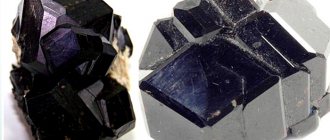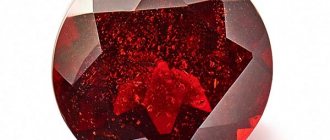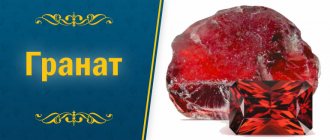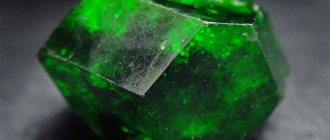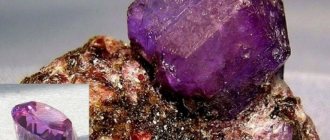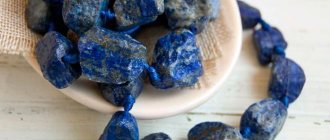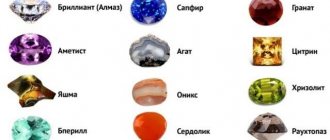| Category | Rock-forming minerals |
| Title in English | Garnet |
| Formula | R2+3 R3+2 [SiO4]3 |
| Group | Pomegranate group |
| Color | Red, Bright Red, Orange, Purple, Green, Purple, Black |
| Stroke color | White |
| Shine | Glass |
| Transparency | Translucent, Transparent, Translucent |
| singonia | Cubic |
| Hardness | 6 — 7,5 |
| Cleavage | Absent |
| Density, g/cm³ | 3,4 — 4,43 |
| Kink | Rough, Conchoidal |
| origin of name | The name of this semi-precious stone is derived from the external resemblance of the color of the mineral to the grains of pomegranate, the fruit of the pomegranate tree. The word pomegranate itself comes from the Latin granatus, which translates as “grainy”. Also, there is a version that the word was formed from the Latin “granum” - it is translated as “grain”. |
| Morphology | Garnet stone forms crystals inside itself, which come in the form of dodecahedrons or tetragontrioctahedrons, as well as isometric grains. They come in the form of granular aggregates. |
Garnet is the collective name for a family of gemstones. According to general beliefs, this mineral is associated with the color red. But in fact, the color palette of garnets is very wide and includes almost all the colors of the rainbow: bright green, red-brown, pink, cherry, yellow-green, orange and other shades. Only garnets painted blue are not found. And the most popular varieties remain the rich red pyrope and the bright green demantoid shining with gold.
Garnet deposits
The most famous garnet deposits are unique placers located in the mountains of the Central Bohemian region, as well as diamond-bearing kimberlite pipes in eastern and southern Africa. Complex deposits of garnets, diamonds and chrysolites were discovered in Yakutia. Certain varieties of pomegranate are also mined in Germany and other European countries.
History of pomegranate
— Advertising —
The name of the mineral “garnet” was given from the Latin word “bagranurn”, which translates as “grain” or “grain”. Externally, this beautiful gem resembles pomegranate seeds. Also, many synonyms are known for the stone, including: shorlomites, melanites, leucogranates, carbuncles, bechet, scales, venice, Ural stone.
The garnet family includes pyrope, almadine, grossular, and spessartine. The dark red color of pyrope was named in Greek for “like fire.”
Importance for the body
Anti-inflammatory
Chronic inflammation occupies one of the first places in the spectrum of all human diseases. Pomegranate fruits are characterized by strong anti-inflammatory properties, which largely depend on the antioxidants contained in the fruit. Studies have shown that pomegranates can reduce inflammation in the gastrointestinal tract.
Cancer protection
Pomegranate can protect against prostate cancer. This is what scientists who conducted experiments using the juice of this berry say. It turned out that the substances contained in pomegranate slow down the proliferation of cancer cells, and in some cases even cause their death [6]. Researchers say that men only need to drink 240 ml of pomegranate juice daily to protect themselves from prostate cancer [7].
The fruit is also beneficial for women. Pomegranate juice will protect representatives of the fairer sex from breast cancer - the most common type of cancer among women.
Against arthritis and joint pain
There are different types of arthritis, but they are all accompanied by inflammation in the joints. Considering that the phytocomponents in pomegranates have anti-inflammatory properties, it makes sense to say that these fruits are useful in the treatment of arthritis. Recent laboratory experiments have confirmed that pomegranate extract can block enzymes that cause joint damage in osteoarthritis [8].
Mushroom grenades!
It turned out that pomegranate juice is also useful in the fight against harmful bacteria and fungi. This fruit will also help people with diseases caused by Candida fungi. Thanks to its antifungal and antibacterial effect, the fruit will protect against infections and inflammations in the oral cavity, such as stomatitis, periodontitis and gingivitis [9].
To improve memory
There is ample evidence that pomegranate fruits are beneficial for brain performance, in particular, they improve memory [10].
The experiment showed that drinking about a glass of juice daily is enough to improve verbal and visual memory. In old age, pomegranate juice will protect against Alzheimer's disease. This fruit is also useful for people after operations.
Benefits for the Heart
High blood pressure can lead to a heart attack or stroke over time, but pomegranate juice can help prevent the disease. Studies have shown that it is enough to drink 150 ml of natural juice for 2 weeks to bring blood pressure within normal limits. And pomegranate acid can strengthen the heart and protect it from certain diseases [11]. In addition, juice has been proven by scientists to effectively reduce cholesterol and triglyceride levels, which is also important for health [12].
Effect on erection
Interestingly, pomegranate juice can improve erections in men. An experiment involving 53 men showed that this fruit improves blood flow, relieving symptoms of erectile dysfunction [13].
Benefits for athletes
Pomegranate is rich in chemical compounds that increase the physical endurance of the body. As a result of the study, it was found that if you take 1 g of pomegranate extract 30 minutes before training, the blood supply to the body will significantly improve, which will ultimately make sports more effective and prevent fatigue. By the way, beet juice also gives a similar result.
Physico-chemical characteristics of garnet
Silicates with an island structure - garnets - combine six types of minerals: pyropes (magnesium-aluminum salt), almandines (aluminum-iron salt), spessartines (mangan-aluminum salt), uvarovites (calcium-chromium salt), grossulars (calcium-aluminum salt ), andradites (calcium-iron salt).
Natural garnets also contain inclusions of titanium and vanadium. — Advertising —
According to the color characteristics, there are various garnets, except blue ones. Pyropes are dark red, almandines are pink or cherry, uvarovites are bright green, pink, colorless, andradites are red-brown, brown.
The hardness of the crystals on the Mohs scale is 6.0-7.5. Specific gravity 3.2-4.3 g/cm3. They are transparent or opaque; as a rule, the brighter the color, the less transparent the sample. They have a glassy, resinous or diamond luster.
STRUCTURE
Crystal structure of garnet
Cubic system, hexoctahedral type of symmetry. The structure of garnets consists of isolated groups (Si04) located along a fourth-order helical axis. This explains the rhombododecahedral and tetragontrioctahedral habit of the crystals, and the change in the ratio between divalent and trivalent cations may apparently be responsible for the predominance of the rhombododecahedral appearance for the calcium series of garnets, and the tetragontrioctahedral for the aluminum series. Based on the nature of isomorphic substitutions, the following are distinguished: I. (Mg, Fe, Mn) AI-garnets, called pyralspites; II. (Al, Fe, Cr) Ca-garnets, called ugrandites. Continuous series have been established: pyrope - almandine, almandine - spessartine, grossular - andradite and andradite - uvarovite. There is no complete isomorphic miscibility between Al-garnets and Ca-garnets.
Types of pomegranate
The most famous variety of garnets is pyrope.
It has been known to man for a very long time, is considered the oldest of its group, is painted in a deep red color, and looks like pomegranate seeds. Its subspecies are rhodolites - stones of an intense pink or pink-violet hue, reminiscent of alexandrite. Almandines or “carbuncles” are the second type of garnet. They resemble rubies and are colored in dark violet-red or cherry tones.
Honey-yellow or orange-brown color is characteristic of spessartines. These unique minerals are often confused with alexandrites.
Grossulars are painted in a delicate greenish color. Andradites are brownish-brown and burgundy.
Uvarovites, also known as Ural emeralds, can be colorless, pink or green.
Unique demantodids are emerald-herbaceous, have absolute transparency, and are the most expensive of the garnets.
MORPHOLOGY
Garnet, Geoffrey Main, Asbestos, Quebec, Canada
The following garnets with an intermediate composition are known, classified as varieties: • Hessonite - Fe-grossular of a specific beautiful red color • Melanite - Ti-andradite with isomorphic replacement of NaTi by CaFe3+ • Shorlomite - a variety highly enriched in titanium, black in color and with a metallic luster • Demantoid - transparent A green to greenish-yellow variety of andradite, with high luster and very high light dispersion. For Ural demantoid stones, most stones are characterized by fibrous radially arranged inclusions of silvery or golden-yellow asbestos-like crystals of bissolite or hollow channels (“horsetail”) remaining from its destruction. These inclusions are not only typical for demantoid, but can even increase its price, since they definitely indicate the naturalness of the stone and, if properly processed, create an additional decorative effect. There are demantoids with a “cat’s eye” effect, which is created in some grains due to the abundance and dense arrangement of inclusions. Demantoid is the most valuable of the garnets. It is easily distinguished from other green gemstones by its high refractive index, lack of birefringence, and strong dispersion. • Topazolite - transparent yellowish-green andradite, yttrium garnet with YAl replaced by CaSi • Kimzeite - with a ZrO2 content of about 20% • Gibsite - with a certain amount of phosphorus, replacing part of the silicon atoms and containing water (hydrogarnets, especially hydrogrossular). • Tsavorite - (named after the place of discovery near the Tsavo National Park and the Tsavo River, Tanzania) - a rare bright green garnet of different shades, a transparent variety of grossular. First found in Africa in 1967 by British geologist Campbell Bridge in the mountains of northeastern Tanzania. Crystals up to 1-5 carats are numerous, and those weighing more than five carats are very rare, therefore faceted tsavorite larger than two carats is rare. A moderately expensive jewelry stone that lends itself well to cutting. Not found in Russia, but already known quite well.
Magical properties of pomegranate
In ancient times, red garnets were considered a symbol of passion.
When their owner is obsessed with any desire, he may notice how the mineral seems to fill with blood. In general, the stone has a positive effect on the owner, it teaches you to reveal your emotions and feelings, gives you the desire to win, fills you with energy and expands your prospects. In addition, pomegranate is a love talisman. It is given to those who are dear and loved in order to maintain good and warm relationships. Red garnet helps politicians reach the heights of power, protects and patronizes travelers, and gives strength and confidence to speakers. For creative people, the mineral becomes a source of new ideas and inspiration. Yellow and orange garnets are suitable for those who love to work; they help such people improve their financial well-being. Orange garnets are excellent amulets for scholars. Green – for those who do business. Pomegranates bring peace and tranquility to family life, become protectors from evil forces and give happiness. Grenades painted gray and black are considered the darkest. They are used in various rituals by magicians and psychics.
How to spot a fake
The cost of a pomegranate is not very high, but it is counterfeited.
It is quite difficult to distinguish natural stone from synthetic stone.
Their hardness, density and shine are the same; moreover, synthetics can be harder. To determine the authenticity of a stone, use one of the following rules:
- rub a piece of stone on wool - a natural mineral, like an ebonite stick, becomes electrified, a synthetic one does not;
- natural stone has a heterogeneous color, and artificial stone has a bright color;
- Specimens larger than a coffee bean should be considered suspicious - such stones are rare in nature.
Natural stone differs from painted glass in hardness - it is much harder.
Medicinal properties of pomegranate
The healing qualities of pomegranates vary depending on their color.
Green and yellow-green stones have a calming effect and help during the recovery period after injury and stroke. They normalize the functioning of the cardiovascular system, cleanse the body, and have a positive effect on vision and hearing.
Red pomegranate improves blood circulation, helps in the treatment of anemia, sexual dysfunction, inflammatory diseases of the throat, and high fever. For these purposes, the stone is worn in the form of a gold ring on the right hand on the middle finger. To treat chronic respiratory diseases, wear a garnet pendant in silver.
Gems in yellow and orange shades provide energy, have a positive effect on the spleen and bone marrow, relieve headaches and facilitate childbirth.
ORIGIN
Grenades
The most widespread are garnets of contact-metasomatic origin, which arise as a result of reactions of predominantly acidic magmas with carbonate rocks (limestones and dolomites) under conditions of relatively high temperatures. They are often found in the form of solid masses (grossular and andradite) or are part of skarns, consisting mainly of calcareous silicates: diopside, hedenbergite, epidote, vesuvianite, sometimes wollastonite, actinolite, chlorites, helvin, etc. Andradite skarns also contain ore minerals. Less common are deposits of garnets (mainly almandine), which arose under the influence of acidic magmas on basic metamorphic rocks (amphibolites, hornblende gneisses, hornblende-chlorite rocks, etc.), especially if the latter are observed in the form of xenoliths among igneous rocks. As new formations, garnets are also widespread in crystalline schists: mica, chlorite, talc, amphibole, etc. The composition of the resulting garnets depends on the composition of the original rocks. During the metamorphism of rocks rich in Al and Fe, almandine is formed, calcareous rocks - grossular, magnesium-alumina rocks - pyrope, etc. In garnet crystals, which sometimes reach significant sizes (up to 1 cm or more), inclusions of foreign minerals are often found, formed in shale. In paragenesis with them, muscovite, biotite, quartz, disthene, sillimanite, graphite, rutile, magnetite, etc. are often observed. Uvarovite and other chromium-rich garnets are quite often observed in the form of well-formed crystals in association with chrome spinels and chrome chlorites in voids (mainly way in cracks) among deposits of chromium iron ores in ultrabasic igneous rocks (Saranovskoe deposit in the Urals). During the process of weathering, garnets, being relatively chemically stable minerals, turn into placers. However, iron garnets decompose during intense weathering processes, forming brown iron ores in the form of iron hats. Manganese garnets are destroyed even more easily with the formation of manganese hydroxides.
Branches of application of pomegranate
The semiconductor properties of garnet are used in industry.
Opaque samples have found application in the manufacture of abrasives. But these stones are still most popular in jewelry. In ancient times, the faces of gods and kings and portraits of people were carved on the polished surface of large garnets, which have survived to this day. Garnets were especially fashionable during the Romantic period. Nowadays they are cut into cabochons and used in a variety of jewelry.
The stone is also used in lithotherapy.
Compatibility with other stones
In this matter, everything is not easy for pomegranate. The fact is that different types of this stone belong to different elements. Pyrope, almandine, grossular are Fire stones. But, for example, uvarovite is the stone of Air. Fire and Air are friendly elements, but Fire, unlike Air, does not combine with Earth.
So, you can choose stones that suit each other according to this scheme. All grenades combine with:
- diamond and diamond;
- ruby;
- coral;
- pyrite;
- heliolite;
- rock crystal;
- topaz;
- amethyst;
- carnelian;
- golden beryl.
Garnet beads
You should not wear them with Water stones - a mutual contradiction will arise (not so strong in the case of uvarovite).
In jewelry, first of all, avoid combinations of garnet:
- with emerald;
- opal;
- aquamarine;
- moonstone;
- alexandrite;
- pearls;
- tourmaline;
- zircon.
In addition to uvarovite, it should also be used with caution. These include:
- jasper;
- chalcedony;
- agate;
- onyx;
- malachite;
- turquoise;
- obsidian;
- morion.
As well as other opaque minerals.
Garnet and zodiac sign
Instances of red, orange and purple colors are suitable for all representatives of the element of Fire, as well as Capricorns and Aquarius.
Dark garnets become good helpers for Capricorns and Scorpios. Green gems are recommended for Libra, Sagittarius and Capricorn. There are no contraindications for using jewelry with garnets for other zodiac signs.
Possible dangers
Pomegranate juice is a very acidic product, and for this reason it is absolutely not suitable for people with stomach ulcers and high acidity. Also, pomegranate acid may not have the best effect on tooth enamel. It is not recommended to give pomegranate juice to children under one year of age. Some cautions are also associated with the peel of the fruit: it contains toxic substances and can cause severe poisoning.
Interesting facts about pomegranate:
- Bright red garnets were called “carbuncles” in ancient times. In Rus' they were known as “worm-shaped yachts”. Very often, “garnet” refers to the red subspecies of this family, and green stones are called “olives.”
- Pomegranate is a good talisman for those involved in risky activities. It protects travelers on dangerous roads. The ancient Romans considered it an indispensable amulet during pregnancy. And in the Middle Ages they believed that using a stone could stop bleeding and protect against wounds. The Crusaders valued rings with almandines, and talismans with engraved lions were supposed to heal all diseases.
- The poet Goethe's muse Ulrika had jewelry made from Bohemian garnet. Their set consisted of 500 stones painted deep red, and today it is kept in the Bohemian Museum.
Who are the names suitable for?
It is extremely important to determine in advance, when buying a garnet stone, who this type of jewelry is suitable for and who is not. The element of garnets is fire (especially for pyropes and almandines), as well as earth and water. This stone also has patron planets: the Moon, Jupiter, Venus, Mars and the Sun.
Pomegranate is an excellent life talisman for people with the names:
- Alexandra (only for women - for Alexander men this mineral will be useless);
- Alla;
- Anton;
- Valeria;
- Basil
- Galina;
- Lyudmila;
- Maria;
- Nikita;
- and Tamara;
